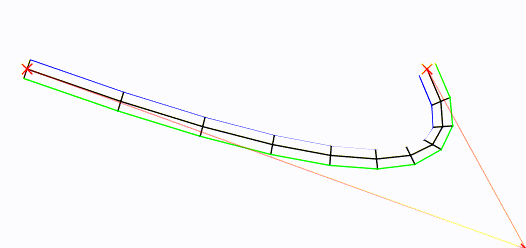Dada una curva "raíz", así es como puede generar vértices de bloque.

La curva raíz está en el medio, en negro. Sus puntos de control se muestran con Xs rojo .
En resumen : hice un Bézier y lo probé (a una velocidad configurable). Luego encontré el vector perpendicular del vector de cada muestra a la siguiente, lo normalicé y lo escalé a un ancho medio (configurable), primero a la izquierda, luego inversamente a la derecha. Luego lo dibujó.
Cosas que podrías agregar a esto:
Aquí está mi código. Está escrito en Lua (para el marco del juego LÖVE ), pero creo que es legible para cualquiera.
local v = require "vector"
-- A function that makes bezier functions
-- Beziers have start point p0
-- control point p1
-- end point p2
local function makeBezierFunction(p0,p1,p2)
return function (t)
local pow = math.pow
return pow( (1-t),2 ) * p0
+ 2 * (1-t) * t * p1
+ pow(t,2) * p2
end
end
love.graphics.setBackgroundColor(255, 255, 255)
function love.draw()
local line = love.graphics.line
local colour = love.graphics.setColor
-- Bezier sampling parameters
local nSegments = 10
local segIncr = 1/nSegments
-- Bezier definition: Start (`p0`), control (`p1`) and end `p2`) point
local p0 = v(100,100)
local p1 = v( love.mouse.getX(), love.mouse.getY() )
local p2 = v(500,100)
local controlPoints = {p0,p1,p2}
local bez = makeBezierFunction(p0,p1,p2)
-- Sample the bezier
for i=0,1-segIncr,segIncr do
colour(0, 0, 0)
local x1,y1 = bez(i ):unpack()
local x2,y2 = bez(i+segIncr):unpack()
line(x1,y1,x2,y2)
-- Find left and right points.
local center = v(x1, y1)
local forward = v(x2, y2) - center
local left = center + forward:perpendicular():normalize_inplace() * 10
local right = center - forward:perpendicular():normalize_inplace() * 10
-- Draw a line between them.
line(left.x, left.y, right.x, right.y)
-- Find *next* left and right points, if we're not beyond the end of
-- the curve.
if i + segIncr <= 1 then
local x3, y3 = bez(i+segIncr*2):unpack()
local center2 = v(x2, y2)
local forward2 = v(x3, y3) - center2
local left2 = center2 + forward2:perpendicular():normalize_inplace() * 10
local right2 = center2 - forward2:perpendicular():normalize_inplace() * 10
-- Connect the left and right of the current to the next point,
-- forming the top and bottom surface of the blocks.
colour(0, 0xff, 0)
line(left.x, left.y, left2.x, left2.y)
colour(0, 0, 0xff)
line(right.x, right.y, right2.x, right2.y)
end
end
-- Draw an X at the control points
for _,p in ipairs(controlPoints) do
local x,y = p:unpack()
colour(0xff,0x00,0x00)
line(x-5,y-5, x+5,y+5)
line(x-5,y+5, x+5,y-5)
end
-- Draw lines between control points
for i=1,#controlPoints do
colour(0xff,0x00,0x00, 100)
local cp1 = controlPoints[i]
local cp2 = controlPoints[i+1]
if cp1 and cp2 then
line(cp1.x, cp1.y
,cp2.x, cp2.y)
end
end
end
Si desea jugar con él: Obtenga LÖVE y coloque el código anterior main.luaen su propio directorio. Poner vector.luade la HUMPbiblioteca en el mismo directorio. Ejecútelo como love <that-directory>desde una línea de comando.
Mueve el mouse! El punto de control central está configurado en la ubicación del mouse:




